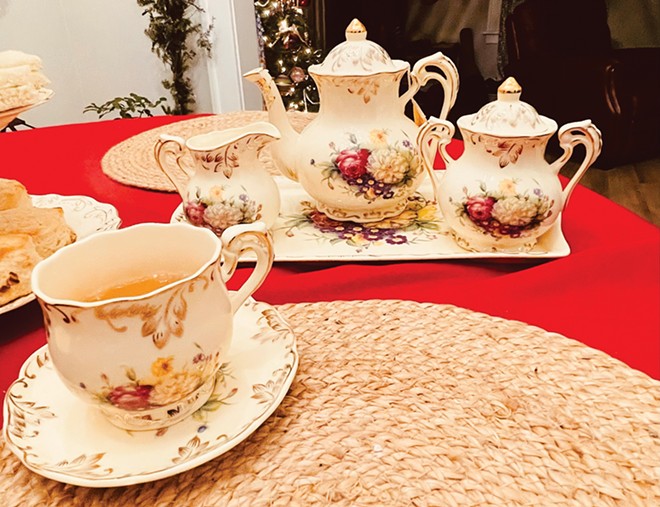This past summer, after my job as a cook at a summer camp in upstate Washington had ended, we decided to travel north and take a car ferry to Vancouver Island to visit Victoria, the capital of British Columbia. Named after Queen Victoria, it's one of the oldest cities in the Pacific Northwest and is known for its heritage architecture and time-honored traditions, such as afternoon tea.
My wife is a serious anglophile with ancestral roots in England, and traditional afternoon tea was something she very much wanted to experience. I was unable to obtain a last-minute reservation for afternoon tea at the famous Empress Hotel and instead booked afternoon tea at the Pendray Inn and Tea House, a Victorian mansion with stunning views of Victoria's Inner Harbor.
Whereas the Empress is considered stately, Pendray Inn would be considered quaint.
In a cheerful, sunlit room with stained glass windows and antique furniture, we enjoyed a delightful afternoon sipping tea out of china teacups and nibbling on savory and sweet treats served on a three-tiered tea stand. We made a commitment to incorporate this tradition into our own daily rituals and acquired a formal English tea set this Christmas.
Afternoon tea is an English tradition dating back to the early 1840s. Back in those days, the practice was to eat only two meals a day: a late breakfast and dinner between 8 and 9 p.m. The story goes that Anna, the Seventh Duchess of Bedford, complained of "having that sinking feeling" during the late afternoon. To ward off her hunger, she would have tea and a light snack served in her room. She started inviting friends to join her at her home for a leisurely afternoon of gossip over a selection of little treats and a pot of tea. These get-togethers evolved into the ritual of afternoon tea.
In the late 1800s, tearooms started opening in railway stations. Tearooms were predominantly all-female establishments and became meeting places for members of the suffragette movement. Tearooms were places where women could meet, away from men, to strategize their "Votes for Women" campaigns. Afternoon tea was also a time when women could be liberated from their corsets and wear loose-fitting tea gowns of silk or chiffon, modeled after Japanese kimonos.
Afternoon tea is usually laid out on fine china, with a large pot of tea and a three-tiered tea stand bedecked with a tier of sandwiches, a tier of scones and a tier of little cakes. It is typically served between 3 and 5 in the afternoon. It's a delightful time to sit back and relax and enjoy good company.
Cucumber and Butter Finger Sandwiches
Serves 4
Make these with good quality sandwich bread, such as Pepperidge Farm Very Thin.
Ingredients:
8 slices white bread
1 English cucumber
Kosher salt
4 tablespoons unsalted butter
Freshly ground white or black pepper
Preparation:
Peel the cucumber and slice it as thinly as possible with a sharp knife or mandoline slicer. Place the slices in a colander, sprinkle lightly with salt and let stand for 20 minutes. Rinse under cold water and arrange slices between two paper towels and pat dry.
Generously spread butter onto one side of each of the bread slices.
Shingle the cucumbers on four of the bread slices, and sprinkle with pepper. Top each with a remaining bread slice to make four sandwiches.
Remove the crusts with a serrated knife and divide them into three equal rectangles.
Egg and Watercress Finger Sandwiches
Ingredients:
8 slices white bread
2 hard-boiled eggs, peeled
4 tablespoons cup finely chopped watercress
3 tablespoons mayonnaise
2 teaspoons Dijon mustard
½ teaspoon finely chopped fresh dill
Kosher salt and freshly ground black pepper
Preparation:
Chop eggs into small pieces. Stir in the watercress, mayonnaise, mustard, dill, salt and pepper.
Spread a thick layer of egg mixture onto four bread slices. Top each with a remaining bread slice to make four sandwiches.
Remove the crusts with a serrated knife and divide into three equal rectangles.
Smoked Salmon and Dill Finger Sandwiches
Ingredients:
8 slices whole wheat sandwich bread
8 ounces cream cheese
2 tablespoons finely chopped fresh dill
4 tablespoons minced red onion
1/2 lemon
Kosher salt and freshly ground black pepper
8 ounces smoked salmon, thinly sliced
Preparation:
Mix together the cream cheese, dill and red onion. Season to taste with lemon juice, salt and pepper.
Spread the cream cheese mixture onto one side of each of the bread slices.
Arrange the salmon evenly over four of the bread slices. Top each with a remaining bread slice to make four sandwiches.
Remove the crusts with a serrated knife and divide into three equal rectangles.
English Cream Scones
The key to making scones is to work the dough as little as possible to keep the glutens in the
flour from overdeveloping, which will make your scones too hard. It is also essential to check the
date on your baking powder. Baking powder loses its potency quickly, and your scones won't
rise properly if your baking powder is more than six months old.
Ingredients:
250 grams (about 2 cups) AP flour, plus more for dusting the work surface
1 tablespoon baking powder
2 teaspoons granulated sugar, plus more for sprinkling
1/2 teaspoon kosher salt
1/2 cup dried currants
3/4 cup heavy cream, plus more as needed
1 egg white, lightly beaten with a little water
Preparation:
Preheat oven to 425° F.
In a large mixing bowl, combine the flour, baking powder, sugar and salt. Stir in the currants and cream until just combined.
Turn the dough out onto a floured board and press it together into a rough ball. If it doesn't hold together, add more cream, a little at a time, until it does. Be careful not to overwork the dough.
Roll the dough out to a thickness of 3/4 inch. Cut into rounds with a 3-inch round biscuit cutter.
Arrange the scones on a parchment-lined baking sheet. Brush the tops of the scones with the egg white and lightly sprinkle with sugar. Transfer the pan to the oven. Bake until golden, 10-12 minutes.

















